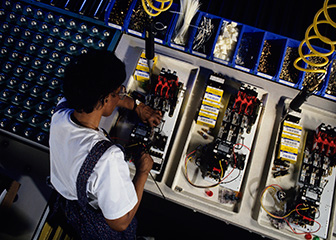
Assemblers and fabricators conduct quality checks for faulty components or mistakes in the assembly process.
Assemblers and fabricators build finished products and the parts that go into them. They use handtools and machines to make vehicles, toys, electronic devices, and more.
Duties
Assemblers and fabricators typically do the following:
- Read and understand schematics and blueprints
- Position or align components and parts either manually or with hoists
- Use handtools or machines to assemble parts
- Conduct quality control checks
- Clean and maintain work area and equipment, including tools
Assemblers and fabricators need a range of knowledge and skills. For example, assemblers putting together complex machines must be able to read detailed schematics. After determining how parts should connect, they use handtools or power tools to trim, cut, and make other adjustments to fit components together. When the parts are properly aligned, they connect them with bolts and screws, or they weld or solder pieces together.
Assemblers look for faulty components and mistakes throughout the assembly process. Such assessments help to ensure quality by allowing assemblers to fix problems before defective products are made.
Modern manufacturing systems use robots, computers, and other technologies. These systems use teams of workers to produce entire products or components.
Assemblers and fabricators may also be involved in product development. Designers and engineers may consult manufacturing workers during the design stage to improve product reliability and manufacturing efficiency. Some experienced assemblers work with designers and engineers to build prototypes or test products.
Although most assemblers and fabricators are classified as team assemblers, others specialize in producing one type of product or in doing the same or similar tasks throughout the manufacturing process.
The following are examples of types of assemblers and fabricators:
Aircraft structure, surfaces, rigging, and systems assemblers fit, fasten, and install parts of airplanes, missiles, or space vehicles. These parts include the wings, landing gear, and heating and ventilating systems.
Coil winders, tapers, and finishers roll wire curs of electrical components used in electric and electronic products, including resistors, transformers, and electric motors. Using handtools, these workers also attach and trim coils or insulation.
Electrical and electronic equipment assemblers build products such as computers, electric motors, and sensing equipment. Unlike in industries with automated systems, much of the small-scale production of electronic devices for aircraft, military systems, and medical equipment must be done by hand. These workers use devices such as soldering irons.
Electromechanical equipment assemblers make and modify mechanical devices that run on electricity, such as household appliances, computer tomography scanners, and vending machines. These workers use tools such as rulers, rivet guns, and soldering irons.
Engine and machine assemblers construct and rebuild motors, turbines, and machines used in automobiles, construction and mining equipment, and power generators.
Fiberglass laminators and fabricators overlay fiberglass onto molds, forming protective surfaces for boat decks and hulls, golf cart bodies, and other products.
Structural metal fabricators and fitters cut, align, and fit together structural metal parts and may help weld or rivet the parts together.
Team assemblers rotate through different tasks on an assembly line, rather than specializing in a single task. Team members may decide how work is assigned and tasks are completed.
Timing device assemblers, adjusters, and calibrators manufacture or modify instruments that require precise measurement of time, such as clocks, watches, and chronometers.
 United States Department of Labor
United States Department of Labor









